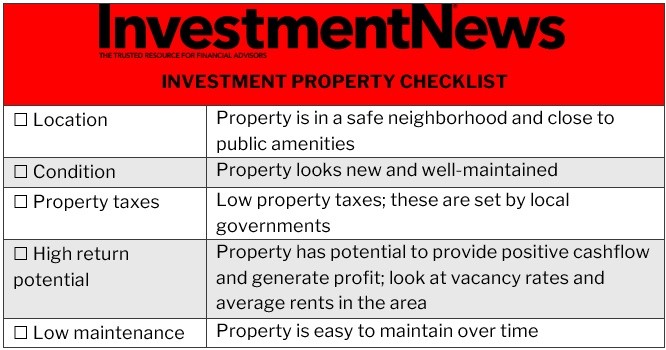

Real estate is considered an attractive investment option because of the potential benefits the market provides. When done right, buying an investment property can be an effective way to build wealth and secure your financial future. But to be successful, you will need careful planning and dedication.
If you’re new to the world of real estate investing and find the process daunting, this guide can help ease your fears. Here, InvestmentNews provides a simple step-by-step approach to investing in rental properties for beginners.
Keep reading and learn tips and strategies on how to use real estate investments to boost your portfolio. To the financial advisors who comprise the bulk of our readership, this client education guide can be a great resource to share with aspiring real estate investors.
Buying an investment property is one of the popular ways of investing in real estate. Investors purchase this type of property for the sole purpose of making a profit. If you decide to buy a real estate property, you can earn a profit, either through:
Depending on your investment goals, there are two types of investment properties you can choose from:
These properties are popular among real estate investors because once up and running, they can generate passive income. Some common examples include:
Investing in residential real estate requires a lot of time and effort, especially if you prefer handling the property management tasks yourself. You will also need to spend money on marketing and maintenance, that’s why it’s important to set aside funding to cover these.
If you would rather attract business tenants, then investing in commercial real estate is the way to go. Your options include:
Just like with residential real estate, you can earn profit from rental income or selling the property. However, you will have different considerations when searching for tenants. This can include business history, industry, and financial stability.
Our picks of the best books for real estate investing may help you decide which of these investment properties suit your financial goals.
Purchasing an investment property involves a lot of moving parts. This makes the process overwhelming, especially for first-time investors. But with the right mindset and due diligence, you can avoid making costly mistakes.
Here’s an easy-to-follow guide on buying rental properties for beginners:
Each investor has their own unique reason for venturing into real estate investments. Before taking the plunge, it’s best to understand yours. Here are some questions to ask yourself:
Answering these questions helps you define your investment goals. By setting clear financial goals, you can get an idea of which properties to focus on and how much funding you will need.
Just like buying your own home, purchasing an investment property requires heavy financing. And if you’re among the real estate investors who don’t have a huge bankroll, taking out an investment loan may be the only way to seal the deal.
Getting approved for a mortgage, however, also involves several steps:
When purchasing a rental property, the down payment is often higher than when buying your primary residence. Generally, you will need to shell out between 15 and 20 percent of the property’s purchase price, depending on the type of loan.
For primary residences, the down payment is around three to five percent. However, you will still need at least 20 percent down payment to avoid paying for private mortgage insurance (PMI). Investment properties are often not covered by PMI.
It’s a good idea to start saving once investing in real estate has started to pique your interest.
A mortgage preapproval is a document from a lender stating that you qualify to borrow a certain amount to purchase a home. Preapproval for an investment property works generally the same as those for primary residences. The document is meant to establish your credibility as a property buyer.
If you’re taking out a conventional loan, you will need a credit score of at least 620, depending on your down payment. The larger your down payment, the lower credit rating you will need to achieve.
Once issued, a mortgage preapproval is valid from 30 to 180 days. Your lender can tell you the exact validity period of your document.
Generally, you will need to apply for a conventional investment loan when purchasing a rental property.
Apart from the down payment and credit score requirements above, you will need to have a maximum debt-to-income (DTI) ratio of 45 percent. This means that your total debts and housing costs shouldn’t exceed 45 percent of your income. Lenders use the DTI ratio to determine your creditworthiness.
Most lenders also require borrowers to have enough cash reserves or other easily liquified assets to cover at least six months’ worth of rental income in case of vacancies.
Additionally, you will need to submit the following documents:
The mortgage approval process can take anywhere from a few days to a few weeks. If the lender needs more information from you, this can prolong the process. The number of applications the lender is dealing with can also affect how long the process takes.
If a conventional investment loan isn't an option, you have alternatives. Here is one of them:
Your preapproval document can give you an idea of the properties you can afford. The next question is, where do you buy an investment property? As a new investor, the best places to look are:
Multiple listing services (MLS): These are databases created by real estate professionals showing all the listings for sale in a region. You will need to work with a real estate agent to access these listings.
Foreclosed homes: These are foreclosed properties up for sale by the US Department of Housing and Urban Development (HUD). These properties aren’t listed on MLS. Instead, you can find them on HUD’s website.
It’s often a good idea to hire a real estate agent who specializes in investment properties. Their knowledge and expertise can help you identify properties that can offer the highest return potential.
But if you still want to search for properties on your own, here’s a checklist of some factors to consider. You can download this file for easy reference.

Once you’ve found a property you like, submit your best offer. A real estate agent can assist you in making a written offer using state-approved contracts. Back this up with proof of funds. This will include the preapproval document from your lender and a copy of the bank statement where your down payment will come.
You and your agent can also try to negotiate on some conditions for the deal to move forward. These can include who will shoulder the costs of:
Once a deal has been finalized, you will need to lock in your financing. Your lender will review the documents you’ve submitted to see if your mortgage application can be approved.
They will also conduct a home appraisal to determine the investment property's value. This ensures that they aren't lending too much. The loan approval process can take between 30 and 45 days.
Do a final walkthrough of the investment property. If issues were found during the home inspection, make sure that these were taken care of. You will have some paperwork to sign before the keys are handed over to you.
Once done, take a brief moment to celebrate! Buying an investment property is a significant step to generating reliable passive income that you can reinvest and grow.
If you feel like purchasing an investment property is too complicated for you, then investing in REITs may be a good alternative.
Just like any type of investment, purchasing a rental property comes with its share of benefits and drawbacks. Let’s go through some of them.
While the housing market may have its ups and downs, it tends to be less affected by market shifts. The property market is also more likely to generate fixed returns even in the present economic climate.
Rental properties have the potential for producing a steady flow of passive income. You can even use your rental income for your mortgage payments. It can also cover other expenses associated with operating your investment property.
As an investment property owner, you can enjoy several tax deductions that allow you to maximize your return of investments.
Over time, the value of the property may rise, along with your rental income. This is especially true if your investment property is in a high-yield area. This also means better cash flow, which you can then use to buy more properties.
Unlike investing in stocks, selling property takes longer. This could put you at a disadvantage, especially if you need quick access to cash.
Buying real estate properties entails heavy financing. The down payment alone can cost in the range of tens to hundreds of thousands of dollars.
Investing in real estate involves several expenses. Mortgage repayments, maintenance and renovations, and landlord insurance are just some of the costs that can easily eat into your returns.
4. Bad tenants
Dealing with bad tenants can be a nightmare. Not only do they cause you emotional stress, but their actions – like failing to pay rent and damaging your property – can easily cost you money.
Here’s a summary of the advantages and disadvantages of investing in real estate property.

If you think the cons of owning an investment property outweigh the pros and you prefer other investments instead, this list of the top REITs to invest in can give you options.
Investment experts say that good property can make or break an investor. This is why careful planning and due diligence are important when you’re searching for the ideal real estate. Here are a few practical tips to help you decide if buying an investment property is for you.
Owning a rental property requires hard work and commitment. To provide you with a steady stream of passive income, your investment property must be well-maintained.
Have enough funds saved up to maintain the property. You’ll never know when emergency maintenance may be needed and if there will be prolonged vacancies.
Ideally, your rental income must be enough to cover your operating and maintenance expenses and still leave you with profit.
Home prices go up and down, much like stocks, but generally trend upward. This rise in market value allows you to upgrade your investment or expand your portfolio.
Keeping your investment property profitable also requires you to keep abreast of market trends. You can do so by visiting our Alternative Investments News Section. Be sure to bookmark this page for easy access to breaking news and the latest industry developments.

The leadership changes coming in June, which also include wealth management and digital unit heads, come as the firm pushes to offer more comprehensive services.

Strategist sees relatively little risk of the university losing its tax-exempt status, which could pose opportunity for investors with a "longer time horizon."

As the next generation of investors take their turn, advisors have to strike a fine balance between embracing new technology and building human connections.

IFG works with 550 producing advisors and generates about $325 million in annual revenue, said Dave Fischer, the company's co-founder and chief marketing officer.

Five new RIAs are joining the industry coalition promoting firm-level impact across workforce, client, community and environmental goals.
RIAs face rising regulatory pressure in 2025. Forward-looking firms are responding with embedded technology, not more paperwork.
As inheritances are set to reshape client portfolios and next-gen heirs demand digital-first experiences, firms are retooling their wealth tech stacks and succession models in real time.
